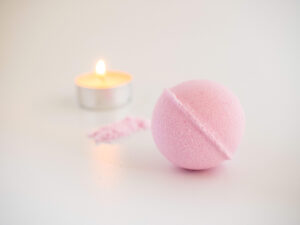What to Watch Out For!

In a world where self-care is increasingly prioritized, bath bombs have emerged as a favorite indulgence. These effervescent spheres transform an ordinary bath into a sensory delight, releasing captivating scents, vibrant colors, and a soothing sizzle. However, not all bath bombs are created equal. While many are crafted with care, some contain ingredients that can be less than desirable for your skin and overall well-being. In this guide, we’ll take a closer look at bath bomb ingredients, helping you make informed choices and avoid potentially harmful additives.
The Basics: What’s in a Bath Bomb?
At its core, a bath bomb is a blend of dry ingredients that fizzes and releases fragrances and color when it comes into contact with water. The key components of a typical bath bomb include:
- Baking Soda (Sodium Bicarbonate): This ingredient is responsible for the fizzing action in bath bombs. It can also help soften the water and soothe the skin.
- Citric Acid: Citric acid, combined with baking soda, creates the fizzing reaction. It also adds a touch of acidity to balance the bath’s pH.
- Epsom Salt (Magnesium Sulfate): Epsom salt is known for its muscle-soothing properties. It can also help detoxify the skin and provide a relaxing bath experience.
- Essential Oils: These natural extracts provide the aromatic element of bath bombs, offering various scents and potential therapeutic benefits.
- Colorants: Many bath bombs use natural or synthetic colorants to create vibrant and visually appealing bathwater.
- Binders: Ingredients like oils or butters are included to bind the mixture together, ensuring the bomb holds its shape until it dissolves in the water.
Now that we understand the basics let’s delve into what to watch out for when selecting bath bombs.
Harmful Additives to Avoid
While bath bombs are meant to enhance your bathing experience, some may contain additives that are less than desirable. Here are the key ingredients and aspects to be cautious about:
- Artificial Fragrances: Beware of bath bombs with artificial fragrances, which can contain phthalates, a group of chemicals used to enhance the scent. Phthalates have raised concerns due to their potential health risks, including hormonal disruption.
- Harsh Dyes: Synthetic dyes can add vibrant colors to bath bombs, but they may contain chemicals that can cause skin irritation or allergic reactions. Look for bath bombs that use natural colorants, such as beetroot powder or spirulina.
- Parabens: Parabens are synthetic preservatives used in cosmetics and personal care products. Some individuals may be sensitive to parabens, which can lead to skin issues.
- Glitter and Mica: While glitter and mica can add a mesmerizing shimmer to bath bombs, many commercial varieties use microplastics that are not environmentally friendly. They can also be harmful if ingested or get into your eyes.
- Sulfates: Bath bombs containing sulfates, like sodium lauryl sulfate (SLS), may produce excessive foam. However, SLS can be harsh on the skin and cause dryness or irritation.
- Alcohol: Some bath bombs may contain alcohol, which can be drying to the skin. If you have dry or sensitive skin, you may want to avoid bath bombs with high alcohol content.
- Synthetic Oils: Although oils are commonly used in bath bombs to moisturize the skin, some bath bombs may contain synthetic oils that don’t provide the same benefits as natural alternatives.
Choosing Safe and Beneficial Bath Bombs
Now that you’re aware of the ingredients to avoid, let’s explore how to make safe and beneficial choices when it comes to bath bombs:
- Read the Ingredients: Always read the ingredient list before purchasing a bath bomb. Opt for products with natural ingredients and avoid those with harmful additives.
- Look for Natural Fragrances: Choose bath bombs scented with essential oils rather than artificial fragrances. Essential oils offer a natural and therapeutic scent.
- Consider the Colorants: To avoid synthetic dyes, select bath bombs that use natural colorants derived from sources like vegetables, herbs, or minerals.
- Check for Organic or Handmade Options: Organic or handmade bath bombs are often crafted with more care and attention to quality ingredients. They’re more likely to be free of harmful additives.
- Seek Recommendations: Ask friends, family, or online communities for recommendations on safe and high-quality bath bomb brands.
- Test the Waters: If you’re trying a new brand, consider doing a patch test on a small area of skin to check for any potential allergic reactions.
- Support Ethical and Eco-Friendly Brands: Choose bath bomb brands that align with your values. Many companies are committed to ethical and eco-friendly practices.

Benefits of Safe Bath Bombs
Safe and well-crafted bath bombs offer numerous benefits for your bathing experience and overall well-being:
- Relaxation: The soothing scents and skin-nourishing ingredients in safe bath bombs can help you relax and de-stress.
- Hydration: Bath bombs that use natural oils and butters can moisturize your skin, leaving it soft and supple.
- Aromatherapy: Essential oils in bath bombs can offer aromatherapy benefits, promoting mental and emotional wellness.
- Detoxification: Some bath bomb ingredients, like Epsom salt, can help detoxify the skin and alleviate muscle tension.
- Eco-Friendly: By choosing bath bombs with eco-friendly ingredients and packaging, you contribute to a more sustainable beauty industry.
In conclusion, bath bombs can be a delightful addition to your self-care routine, offering relaxation and a touch of luxury to your bath time. However, it’s crucial to be aware of potential harmful additives in some products. By making informed choices, you can fully enjoy the magic of bath bombs while prioritizing your health and well-being. So go ahead, pick up a safe and natural bath bomb, draw yourself a bath, and immerse yourself in a world of aromatic bliss and relaxation.

